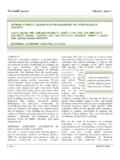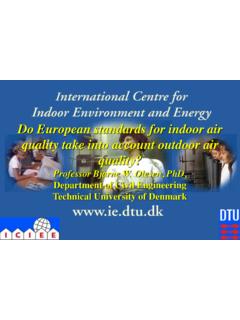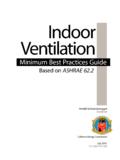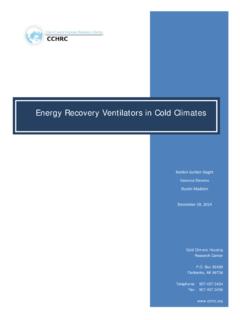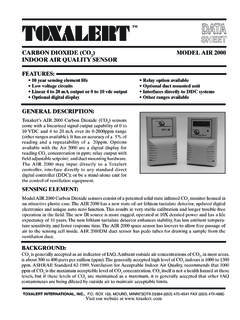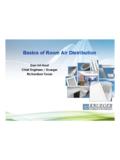Transcription of GREEN DESIGN AND SUSTAINABILITY IN SPORT …
1 The SMART Journal Spring/Summer 2008 Volume 4, Issue 2 Page 26 INTRODUCTION SPORT and recreation organizations have traditionally attempted to construct functional and innovative facilities to meet the needs of patrons. Over the past few decades, the concepts of GREEN DESIGN and SUSTAINABILITY have evolved as a mechanism to deal with limited resources and reduce the impact on the environment (Kessenides, 2005). Architects, engineers, and consultants have begun practicing social responsibility by incorporating GREEN DESIGN concepts and technologies for their client s projects. SPORT and recreation professionals can benefit by gaining an understanding of the potential benefits of GREEN DESIGN and SUSTAINABILITY . This article is an attempt to answer many of the commonly asked questions related to the DESIGN , construction, and maintenance of GREEN facilities. DEFINING GREEN AND SUSTAINABILITY A GREEN or sustainable facility is a structure designed, built, renovated, or operated in an ecologically and resource-efficient manner (Dick, 2007).
2 These buildings often utilize energy-efficient processes to accomplish long-term cost savings (Yost, 2002) SUSTAINABILITY has also been defined as a holistic approach to protecting the environment by incorporating DESIGN practices and materials that use energy most efficiently (Fried, 2005, ). Sustainable initiatives work with the environment rather than against it (Suttell, 2006). GREEN buildings can be designed to protect occupant health, improving employee productivity, utilize resources more efficiently, and reduce environmental impacts (Environmental Building News, 1999). GREEN FACILITY BENEFITS Ries and Bilec (2006) suggest three possible benefits of GREEN facility construction: 1) conservation of natural resources, 2) increased energy efficiency and water conservation, and 3) improved indoor environment. They suggest GREEN DESIGN can lead to substantial cost-savings over the life-span of a building and improve productivity for the building s inhabitants.
3 These potential benefits are discussed in the following sections. NATURAL RESOURCE CONSERVATION The efficient use of natural resources is a fundamental tenet of GREEN DESIGN . Conventional construction practices consume large quantities of steel, wood, plastic, cardboard, paper, water, and other natural resources that unnecessarily lead to resource depletion (del Monte, 2006). DESIGN professionals have the option to select environmentally-conscience building materials such as recycled products. Reutilization of beams, lumber, flooring, paneling, doors, brick, steel, insulation, and other products often lend quality and durability exceeding ISSUES IN PRACTICE MANAUSCRIPT GREEN DESIGN AND SUSTAINABILITY IN SPORT AND RECREATION FACILITIES FRED GIBSON, PHD, WESTERN KENTUCKY UNIVERSITY JEFFREY LLOYD, MS, INDIANAPOLIS COLTS SONYA BAIN, MS, SOUTHEAST MISSOURI STATE UNIVERSITY ATHLETICS DEREK HOTTELL, MS, SEATTLE UNIVERSITY RECREATIONAL sports The SMART Journal Spring/Summer 2008 Volume 4, Issue 2 Page 27 conventional materials (del Monte, 2006).
4 Sustainable construction products can also include recycled plastics and crushed rock aggregates ( GREEN Building Council, 2007). The rapidly developing recycled product market is also diverting waste from landfills as mandated by the Integrated Waste Management Act (Environmental Management, 2007). Designing adequate space for recycling collection and incorporating a solid waste management program can reduce waste generation over the lifespan of facility. ENERGY EFFICIENCY AND WATER CONSERVATION Energy efficiency and water conservation are cornerstones of any GREEN building project. Generation and use of energy are major contributors to air pollution and global climate change. Improving energy efficiency and using renewable energy sources are effective ways to reduce the potential of energy supply interruptions, improve air quality, and reduce the impacts of global warming (Ries & Bilec, 2006).
5 Lowering utility expenses allows organizations to reap the financial benefits of SUSTAINABILITY on a continual basis. Examples of increased energy efficiency measures include installing top grade insulation, glazed and low-emissive (low-E) double-paned windows, and high-efficiency water heaters and other appliances (Ries & Bilec, 2006). LaRue, Sawyer, and Vivian (2005) describe how the building envelope the windows, doors, walls, floor, foundation, and roof must balance requirements for ventilation with providing thermal and moisture protection appropriate to a facility s climatic conditions: The role of mechanical systems and purchased energy is to make up the difference between that which the envelope can provide in occupant comfort and what is [therefore the] quality of the envelope, then, is a major factor in determining energy used for heating, cooling, lighting, and ventilation.
6 Improvements to the envelope can significantly reduce energy demand. (p. 172) An optimal designed building envelope provides significant reductions in heating and cooling loads, which in turn can allow downsizing of heating, ventilation, and air-conditioning (HVAC) equipment (Loftness, Hakkinen, Ada, & Nevalainen, 2007). Large volumes of water are often consumed at recreation and SPORT venues making water conservation an import issue. Builders can take advantage of a new generation of high-efficiency appliances and landscape water management systems (Dick, 2007). Dual plumbing using recycled water for toilet flushing or a gray water system that recovers rainwater or other non-potable water for site irrigation are efficient methods of water conservation. Wastewater can be minimized by using ultra low-flush toilets, low-flow shower heads, and other water conserving fixtures (Dick, 2007; LaRue et al.)
7 , 2005). Additional measures such as reminding patrons to turn faucets off completely, repairing drips and leaks, and shutting down water supplies outside of operating hours can go a long way toward conservation and cost reduction (LaRue et al., 2005). ENHANCED indoor ENVIRONMENT The purpose of a building is not only to provide shelter for its occupants, but also to provide an environment conducive to high performance of all intended occupant activities (Kessenides, 2005). Recent studies reveal that buildings with good overall environmental quality can reduce the rate of respiratory disease, allergy, asthma, sick building symptoms, and enhance worker performance. High-efficiency in-duct filtration systems and heating and cooling systems that ensure adequate ventilation can have a dramatic and positive impact on indoor air quality (Fisk & Rosenfeld, 1998). Poor indoor air quality can be caused by the off-gassing of chemicals found in many building materials as well as mold and mildew that build up in poorly designed and maintained heating and cooling systems.
8 Selection of The SMART Journal Spring/Summer 2008 Volume 4, Issue 2 Page 28 appropriate microbial resistant materials can prevent this indoor microbial contamination. Effective drainage from the roof and surrounding landscape, installing adequate ventilation in bathrooms, allowing for proper drainage of air-conditioning coils, and designing building systems to control humidity can also work to improve indoor conditions. Choosing construction materials and interior finish products with zero or low emissions improve indoor air quality (Dick, 2007). One of the most common interior pollutants is formaldehyde, a suspected human carcinogen. Cabinetry, shelving, and furniture are all typically made from particleboard held together by formaldehyde-based adhesives. The formaldehyde is released into the facility for years after these products have been installed.
9 Many building materials and cleaning/maintenance products emit toxic gases, such as volatile organic compounds (VOC) and formaldehyde. The new building smell is actually the odor of these VOC s off-gassing, and is a sign that there are harmful chemicals in the indoor environment detrimentally impacting occupant health and productivity (Loftness et al., 2007). The building products industry has responded to these indoor pollution problems by developing alternative paint, finish, and adhesive products. For example, solvent-free adhesives used in flooring can eliminate many of the suspected and known human carcinogens. Paints, varnishes, and cleaners that do not contain volatile compounds are now commonly available from most major manufacturers at costs comparable to conventional products (Dick, 2007). Additional measures specific to new construction and major facility upgrades are: investigate the use of separate outside-air and conditioned-air distribution systems; ensure fresh air intakes are located away from loading areas, exhaust fans, and other contamination points; ensure parking lot and garage usage cannot generate pollutants that affect fresh air intake; investigate the use of a permanent air quality monitoring system to ensure acceptable levels of carbon dioxide (CO2) for an indoor office environment are maintained continuously; and replace filters on a periodic basis (Loftness et al.)
10 , 2007). AUTOMATION OF BUILDING SYSTEMS Five areas of emphasis exist to attain a Leadership in Energy and Environmental DESIGN (LEED) certification, a benchmark for GREEN construction created by the GREEN Building Council; however, two of these areas, Energy and Atmosphere and indoor Air Quality, are heavily influenced by controls and hold more potential for cost savings due to automation than the other sections (Dorsey, 2006). In the pre- GREEN period of commercial and institutional facility DESIGN , the building envelope drove decisions regarding lighting, temperature, and ventilation. In today s climate, zoning has become a key word. Zoning is defined as grouping areas of like use for to enhance comfort and cost-effectiveness (Dorsey, 2006). GREEN buildings take these comfort factors to the next level, demanding more personal control of systems. Such measures not only lead to greater comfort and more productivity, they also tend to use energy more efficiently and create an improved indoor air quality (LaRue et al.
